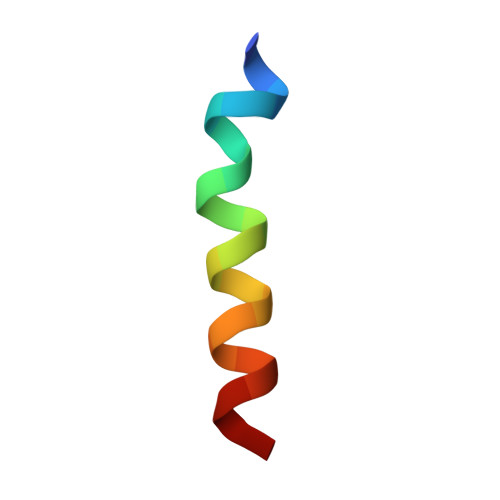Membrane perturbing activities and structural properties of the frog-skin derived peptide Esculentin-1a(1-21)NH2 and its Diastereomer Esc(1-21)-1c: Correlation with their antipseudomonal and cytotoxic activity
Loffredo, M.R., Ghosh, A., Harmouche, N., Casciaro, B., Luca, V., Bortolotti, A., Cappiello, F., Stella, L., Bhunia, A., Bechinger, B., Mangoni, M.L.(2017) Biochim Biophys Acta 1859: 2327-2339
- PubMed: 28912103
- DOI: https://doi.org/10.1016/j.bbamem.2017.09.009
- Primary Citation of Related Structures:
5XDJ - PubMed Abstract:
Antimicrobial peptides (AMPs) represent new alternatives to cope with the increasing number of multi-drug resistant microbial infections. Recently, a derivative of the frog-skin AMP esculentin-1a, Esc(1-21), was found to rapidly kill both the planktonic and biofilm forms of the Gram-negative bacterium Pseudomonas aeruginosa with a membrane-perturbing activity as a plausible mode of action. Lately, its diastereomer Esc(1-21)-1c containing two d-amino acids i.e. D Leu14 and D Ser17 revealed to be less cytotoxic, more stable to proteolytic degradation and more efficient in eradicating Pseudomonas biofilm. When tested in vitro against the free-living form of this pathogen, it displayed potent bactericidal activity, but this was weaker than that of the all-l peptide. To investigate the reason accounting for this difference, mechanistic studies were performed on Pseudomonas spheroplasts and anionic or zwitterionic membranes, mimicking the composition of microbial and mammalian membranes, respectively. Furthermore, structural studies by means of optical and nuclear magnetic resonance spectroscopies were carried out. Our results suggest that the different extent in the bactericidal activity between the two isomers is principally due to differences in their interaction with the bacterial cell wall components. Indeed, the lower ability in binding and perturbing anionic phospholipid bilayers for Esc(1-21)-1c contributes only in a small part to this difference, while the final effect of membrane thinning once the peptide is inserted into the membrane is identical to that provoked by Esc(1-21). In addition, the presence of two d-amino acids is sufficient to reduce the α-helical content of the peptide, in parallel with its lower cytotoxicity.
Organizational Affiliation:
Laboratory affiliated to Pasteur Italia-Fondazione Cenci Bolognetti, Department of Biochemical Sciences, Sapienza University of Rome, Rome, via degli Apuli, 9, 00185, Italy.














